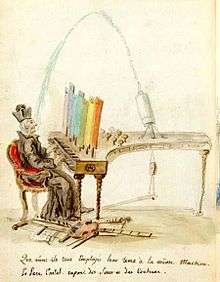Louis Bertrand Castel
| Society of Jesus | |
History of the Jesuits | |
Louis Bertrand Castel (15 November 1688 – 9 January 1757) was a French mathematician born in Montpellier, and entered the order of the Jesuits in 1703. Having studied literature, he afterwards devoted himself entirely to mathematics and natural philosophy. He wrote several scientific works, that which attracted most attention at the time being his Optique des couleurs (1740), or treatise on the melody of colors. He also wrote Traité de physique sur la pesanteur universelle des corps (1724), Mathématique universelle (1728), and a critical account of the system of Sir Isaac Newton in 1743.
Work in optics

It was in 1740 that Louis Bertrand Castel published a criticism of Newton's spectral description of prismatic colour[1] in which he observed that the colours of white light split by a prism depended on the distance from the prism, and that Newton was looking at a special case. It was an argument that Goethe later developed in his Theory of Colours.[2]
The Ocular Harpsichord

Early on, Castel illustrated his optical theories with a proposal for a Clavecin pour les yeux (Ocular Harpsichord, 1725). While the treatise and the illustration were apparently forgotten,[3] he continually developed the idea. A new series of articles, published in the Mercure de France in 1735, gave his idea wider currency.[4] In 1739 the German composer Telemann went to France to see Castel's Ocular Harpsichord for himself. He ended up composing several pieces for it, as well as writing a description of it.[5] The ocular harpsichord had sixty small coloured glass panes, each with a curtain that opened when a key was struck. A second, improved model of the harpsichord was demonstrated for a small audience in December of 1754. Pressing a key caused a small shaft to open, in turn allowing light to shine through a piece of stained glass.[6][7] Castel thought of color-music as akin to the lost language of paradise, where all men spoke alike, and he claimed that thanks to his instrument’s capacity to paint sounds, even a deaf listener could enjoy music.[8]
See also
References
- ↑ Louis-Bertrand Castel (1740). L'Optique des couleurs. Paris.
- ↑ Thomas L. Hankins and Robert J. Silverman (1995). Instruments and the Imagination. Princeton University Press. ISBN 0-691-00549-4.
- ↑ Hugh James Rose (1857). A New General Biographical Dictionary. London: B. Fellowes, &c.
- ↑ Maarten Franssen (1991). ′The Ocular Harpsichord of Louis-Bertrand Castel′, Tractrix 3, p. 39.
- ↑ Descriptions of an Eye-Organ or the Eye-Harpsichord Invented by the Famous Herr Pater Castel, 1739, as cited by Elder, R. Bruce (2008), Harmony and Dissent: Film and Avant-garde Art Movements in the Early Twentieth Century, Film and Media Studies 3, Wilfrid Laurier Univ. Press, p. 54, ISBN 9781554580286.
- ↑ Jae-sung PDF
- ↑ Maura McDonnell, "Visual music".
- ↑ The Scale and the Spectrum James Peel Cabinet (magazine), Winter 2006
 This article incorporates text from a publication now in the public domain: Chisholm, Hugh, ed. (1911). "Castel, Louis Bertrand". Encyclopædia Britannica (11th ed.). Cambridge University Press.
This article incorporates text from a publication now in the public domain: Chisholm, Hugh, ed. (1911). "Castel, Louis Bertrand". Encyclopædia Britannica (11th ed.). Cambridge University Press.
External links
- "Musique Oculaire" in Edmé-Gilles Guyot, Nouvelles récréations physiques et mathématiques, Gueffier, Paris 1770, pp. 234-240.
- 1911 Britannica article "Louis Bertrand Castel"
- LA Weekly "Laserium" article
- O'Connor, John J.; Robertson, Edmund F., "Louis Bertrand Castel", MacTutor History of Mathematics archive, University of St Andrews.
- Maarten Franssen, "The Ocular Harpsichord of Louis-Bertrand Castel". Tractrix: Yearbook for the History of Science, Medicine, Technology and Mathematics 3, 1991.
|
